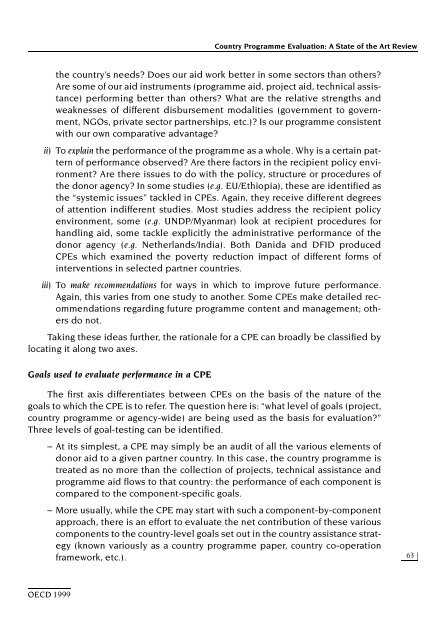Evaluating Country Programmes - OECD Online Bookshop
Evaluating Country Programmes - OECD Online Bookshop
Evaluating Country Programmes - OECD Online Bookshop
You also want an ePaper? Increase the reach of your titles
YUMPU automatically turns print PDFs into web optimized ePapers that Google loves.
<strong>OECD</strong> 1999<br />
<strong>Country</strong> Programme Evaluation: A State of the Art Review<br />
the country’s needs? Does our aid work better in some sectors than others?<br />
Are some of our aid instruments (programme aid, project aid, technical assistance)<br />
performing better than others? What are the relative strengths and<br />
weaknesses of different disbursement modalities (government to government,<br />
NGOs, private sector partnerships, etc.)? Is our programme consistent<br />
with our own comparative advantage?<br />
ii) To explain the performance of the programme as a whole. Why is a certain pattern<br />
of performance observed? Are there factors in the recipient policy environment?<br />
Are there issues to do with the policy, structure or procedures of<br />
the donor agency? In some studies (e.g. EU/Ethiopia), these are identified as<br />
the “systemic issues” tackled in CPEs. Again, they receive different degrees<br />
of attention indifferent studies. Most studies address the recipient policy<br />
environment, some (e.g. UNDP/Myanmar) look at recipient procedures for<br />
handling aid, some tackle explicitly the administrative performance of the<br />
donor agency (e.g. Netherlands/India). Both Danida and DFID produced<br />
CPEs which examined the poverty reduction impact of different forms of<br />
interventions in selected partner countries.<br />
iii) To make recommendations for ways in which to improve future performance.<br />
Again, this varies from one study to another. Some CPEs make detailed recommendations<br />
regarding future programme content and management; others<br />
do not.<br />
Taking these ideas further, the rationale for a CPE can broadly be classified by<br />
locating it along two axes.<br />
Goals used to evaluate performance in a CPE<br />
The first axis differentiates between CPEs on the basis of the nature of the<br />
goals to which the CPE is to refer. The question here is: “what level of goals (project,<br />
country programme or agency-wide) are being used as the basis for evaluation?”<br />
Three levels of goal-testing can be identified.<br />
– At its simplest, a CPE may simply be an audit of all the various elements of<br />
donor aid to a given partner country. In this case, the country programme is<br />
treated as no more than the collection of projects, technical assistance and<br />
programme aid flows to that country: the performance of each component is<br />
compared to the component-specific goals.<br />
– More usually, while the CPE may start with such a component-by-component<br />
approach, there is an effort to evaluate the net contribution of these various<br />
components to the country-level goals set out in the country assistance strategy<br />
(known variously as a country programme paper, country co-operation<br />
framework, etc.).<br />
63

















![CQE=U]^\]Z: KAZAKHSTAN - OECD Online Bookshop](https://img.yumpu.com/3915768/1/190x253/cqeuz-kazakhstan-oecd-online-bookshop.jpg?quality=85)